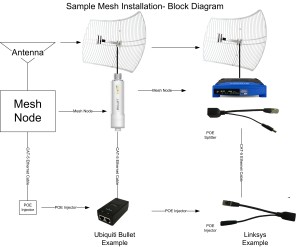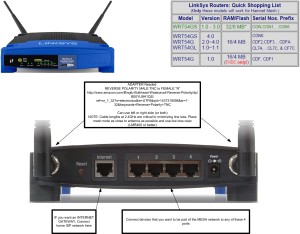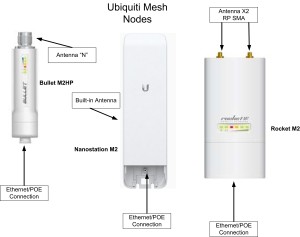Simply, it’s hams using our radio privileges to operate a private, self-contained wireless computer network. Anything that can be done on a regular network/internet can be done on this private Wi-Fi network. The HAM Mesh Network uses off-the-shelf Wi-Fi equipment that has been modified to permit equipment to be used on HAM frequencies under Part 97 rules. This means much higher power can be used, where needed, to establish links between wireless routers (Nodes in HAM Mesh lingo). Links between nodes can be achieved for miles and miles limited by line-of-site.
A Few Examples of Possible Uses of a HAM Mesh Network:
| Success! |
|
Application |
|
✔ |
|
|
Field Day Logging (e.g., N1MM) |
|
✔ |
|
|
Video (e.g., webcams) |
|
✔ |
|
|
Phone (VoIP) |
|
✔ |
|
|
File transfer (FTP) |
|
✔ |
|
|
Chat |
|
✔ |
|
|
Email |
|
✔ |
|
|
Screen mirroring |
|
✔ |
|
|
Web server (e.g., WX station) |
|
✔ |
|
|
Map server |
How does this technology benefit Amateur Radio?
The biggest benefit is to our Emergency Communications operations. During a large emergency or disaster there is always the risk that the normal infrastructure, electrical power, telephone service, cell service, internet, etc. will fail. Traditionally, this is where Amateur Radio is strong in being able to provide needed communications during these times of need.
By adding this suite of computing power to the mix, computer operations can also be established for the use of responders when the internet and cell networks are down. All the data can be processed locally then transferred when things return to normal.
Hardware examples:
Mesh Networking Lingo:
Access Point (AP)
A device that acts as the bridge between wireless clients and the wired network. Often abbreviated as AP.
Ad Hoc Mode
A peer to peer mode of networking using Wi-Fi networking but no access point. Ad Hoc networks can include more than two devices.
Beacon
A beacon is transmitted by an AP ten times per second, and advertises the existence of the AP on a particular channel or channels. It includes information needed by clients to associate and may include the ESSID, the supported channels and data rates, and whether it is open or requires authentication. In HAM Radio mesh networking, the owners ham radio callsigh is also broadcast.
Channel
A channel is the network path for wireless transmissions. Each Wi-Fi standard has numerous channels, each of which is a center frequency. There are 11 channels in 802.11b and g networks in the United States and Canada; 14 in most other countries. Channels have a bandwidth-the greater the bandwidth, the greater the potential throughput. Ham Mesh bandwidth can be set to 5 MHz, 10 MHz, and 20 MHz.
Diversity
Using multiple antennae to reduce interference and improve both transmission and reception of signals. LinkSys nodes and some Ubiquiti nodes use two antennae in diversity mode for better link quality. This is also referred to MIMO.
MIMO
Multiple Input/Multiple Output signaling that uses several transceivers and antennae to improve throughput and range of the wireless network. APs with more than one antenna uses MIMO.
Node
A node is a device that was originally a wireless router that has been converted to transfer data between other nodes in the mesh network. Nodes are self discovering, self configuring, self advertising and fault tolerant.
Peer to peer
In mesh networking, nodes are peer to peer devices. That is, if a node is within radio range of another node and they broadcast the same SSID, they will connect to each other.
SSID
The Service Set Identifier (SSID) is the name of the wireless network. It is contained in the beacons sent out by the nodes.






